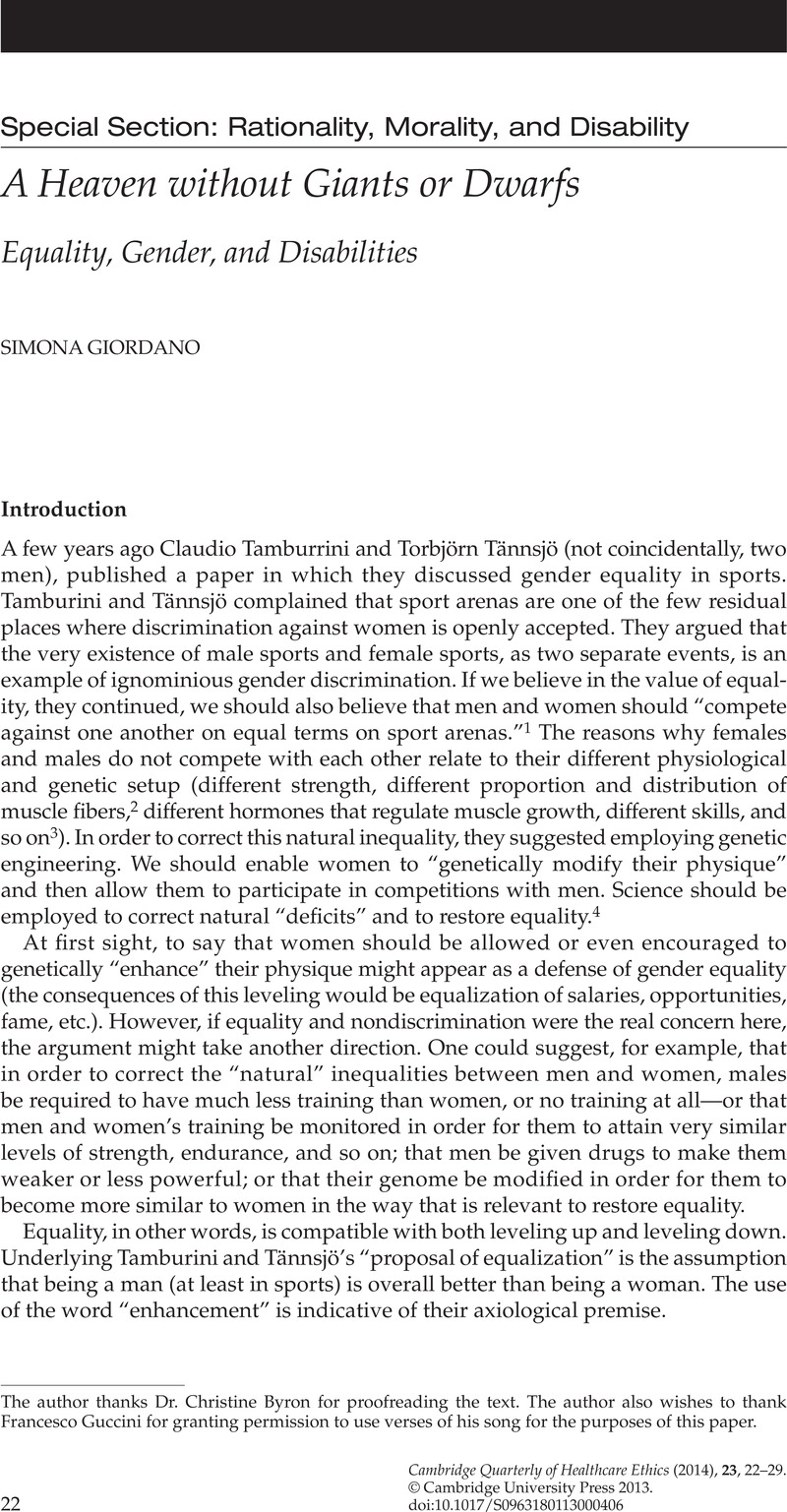No CrossRef data available.
Equality, Gender, and Disabilities
Published online by Cambridge University Press: 20 November 2013

1. Tamburrini, MC, Tännsjö, T. The genetic design of a new Amazon. In: Tamburrini, MC, Tännsjö, T, eds. Genetic Technology and Sport: Ethical Questions. London: Routledge; 2005:181–98.CrossRefGoogle Scholar
2. Staron, SR, Hagerman, FC, Hikida, RS, Murray, TF, Hostler, DP, Crill, MT, et al et al. . Fiber type composition of the vastus lateralis muscle of young men and women. Journal of Histochemistry and Cytochemistry 2000;48:623–30.CrossRefGoogle ScholarPubMed See also Coulson, M. The Fitness Instructor’s Handbook. 2nd ed.London: Bloomsbury; 2013Google Scholar, see in particular chapters 3 and 6.
3. Esbjiornsson, M, Sylven, C, Holm, I, Jansson, E. Fast twitch fibres may predict anaerobic performance in both females and males. International Journal of Sports Medicine 1993;14(5):257–63.CrossRefGoogle Scholar See also Glenmark, B, Nilsson, M, Gao, H, Gustafsson, JA, Dahlman-Wright, K, Westerblad, H. Difference in skeletal muscle function in males vs. females: Role of estrogen receptor- β. American Journal of Physiology, Endocrinology and Metabolism 2004;287:E1125–E1131.CrossRefGoogle ScholarPubMed
4. See note 1, Tamburrini, Tännsjö 2005, at 189.
5. Preamble. Universal Declaration of Human Rights; 1948; available at http://www.un.org/Overview/rights.html (last accessed 4 July 2013).
6. Available at https://www.gov.uk/rights-disabled-person/the-equality-act-2010-and-un-convention (last accessed 4 July 2013).
7. See, e.g., the UN convention on the rights of persons with disabilities; available at http://www.un.org/disabilities/convention/conventionfull.shtml. Among the earlier treatises, see UNESCO. World Declaration for Education for All; 1990; available at http://www.unesco.org/education/pdf/JOMTIE_E.PDF#search=’World%20Declaration%20for%20Education%20for%20All%201990’; UN. The Standard Rules on the Equalization of Opportunities for Persons with Disability; 1993; available at http://www.un.org/documents/ga/res/48/a48r096.htm; UNESCO. Dakar Framework for Action; 2000; available at http://unesdoc.unesco.org/images/0012/001211/121147e.pdf; Commission on Human Rights Resolution 2000/51. Human Rights of Persons with Disabilities; available at http://www.unhchr.ch/huridocda/huridoca.nsf/(Symbol)/E.CN.4.RES.2000.51.En?Opendocument; UN. Working towards a Disability Convention; 2003; available at http://www.un.org/esa/socdev/enable/rights/IDA_Statement_UN_Dis_Con_03-03-02.pdf. All the links have been last accessed on 1 July 2013.
8. Dworkin, R. What is equality? Part 1, equality of welfare. Philosophy and Public Affairs 1981;10:185–246, at 185.Google Scholar
9. Takala, T. What is wrong with global bioethics? On the limitations of the four principles approach. Cambridge Quarterly of Healthcare Ethics 2001;72–77, at 73.CrossRefGoogle ScholarPubMed
10. Giordano, S. Do we need (bio)ethical principles? In: Hayry, M, Takala, T, Herissone-Kelly, P, Arnason, G, eds. Arguments and Analysis in Bioethics. New York/Amsterdam: Rodopi; 2010:37–48.CrossRefGoogle Scholar
11. Giordano, S. Health care rationing: Demographic revolution and inescapable consequences? Cambridge Quarterly of Healthcare Ethics 2005;14:83–92.Google Scholar
12. Rousseau, JJ. Du Contract social, ou Principes du droit politique. Amsterdam: Chez Rey MM; 1972, book 1, chap. IX. My translation.Google Scholar
13. Durkheim, E. The Elementary Forms of the Religious Life. Oxford: Oxford University Press; 2001Google Scholar; this quote is available at http://www.emiledurkheim.com/emile_durkheim_quotes.htm (last accessed 4 July 2013).
14. See, e.g., Boorse, C. Concepts of health. In: VanDeveer, D, Regan, T, eds. Health Care Ethics: An Introduction. Philadelphia: Temple University Press; 1987:372.Google Scholar
15. Harris, J. Is there a coherent social conception of disability? Journal of Medical Ethics 2000;26:95–100.CrossRefGoogle Scholar
16. Oliver, M. Understanding Disability: From Theory to Practice. Basingstoke: Palgrave Press; 1996CrossRefGoogle Scholar, at 32, quoted in Dewsbury, G, Clarke, K, Randal, D, Rouncefield, M, Sommerville, I. The anti-social model of disability. Disability & Society 2004;19(2):147.CrossRefGoogle Scholar
17. For a discussion, see Imrie R. Demystifying disability: A review of the International Classification of Functioning, Disability and Health. Sociology of Health & Illness 2004;26(3):287–305, in particular 295.
18. See note 16, Dewsbury et al. 2004.
19. World Health Organization. International Classification of Impairments, Disabilities and Handicaps (ICIDH). Geneva: World Health Organization; 1980.
20. World Health Organization. International Classification of Functioning, Disability and Health (ICF). Geneva: World Health Organization; 2001.
21. See note 17, Imrie 2004, at 291.
22. Lalli, C. Libertà procreativa. Napoli: Liguori; 2004, at 134.Google Scholar
23. Cencio, Guccini F.. In: Guccini, F. Quello che non . . . Milan: EMI ricordi; 1990.Google Scholar
24. Pitt, V, Curtin, M. Integration versus segregation: The experiences of a group of disabled students moving from mainstream school into special needs further education. Disability & Society 2004:19(4):387–401, at 392.CrossRefGoogle Scholar
25. Masters, EL (1868–1950). Spoon River Anthology. New York: Macmillan; 1916Google Scholar.